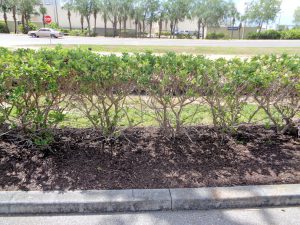
Using shrubs or small trees to make hedges is a common landscape practice in our area. Hedges – whether formal or informal – make great ornamental living screens, barriers and buffers that add to the attraction and utility of our home grounds. Beyond installing hedges, the care and maintenance of hedges – especially pruning – is essential to a healthy and useful hedge. Unfortunately, we live in a world of upside-down hedges – let’s see how to curb this disturbing trend!
Hedges are usually set up as either formal or informal living structures. Formal hedges are well known as they are pruned into some variation of a sculpted three-dimensional shape. The best management practice on this should include trimming the hedge so that it has a narrow top and a wide base. This allows the sun to reach all portions of the exposed foliage so that is develops into full, busy growth. Imagine a trapezoid-shape as the preferred final look with refined lines as you would expect with formal hedge maintenance. A cone-shape is also acceptable, but bottom-line, prune to conform to a narrow top and wide base. A well-shaped formal hedge is solid and not leggy or bare at the base. Formal hedges should be carefully and selectively clipped while the new growth is green and succulent.
Informal hedges are more often used to keep the individual shape of the shrub intact with minimal pruning – just enough to keep the hedge in-bounds, but without the rigid lines and borders. Informal hedges are more likely to be used as a screen or buffer where the individual nature of a shrub is maintained and not blended into one unit as is seen with a formal hedge. Informal hedges better preserve the unique characteristics of each plant within the row.
The main problem that you see locally is that hedges are trimmed and developed upside down – instead of a narrow top and a wide base, you see a wide top and a narrow base. This results in leggy, open growth that does not function much as a hedge, but a see-through network of bare branches. The wide top has some foliage, but the sides and base are often bare or with sparse foliage. This open space if often filled with nonparasitic plants such as ball moss that use the space vacated by foliage.
The cultural practice of proper pruning is very important – even for hedges. Proper development of a hedge – formal or informal – is key to the outcome of an attractive and functional hedge. For more information on pruning woody plants, or to ask a question, please visit https://www.facebook.com/CharlotteCountyExtension . You can also call the Master Gardener Volunteer Helpdesk on Mondays, Wednesdays and Fridays from 1 to 4 pm at 764-4340 for gardening help and insight into their role as an Extension volunteer. Ralph E. Mitchell is the Director/Horticulture Agent for UF/IFAS Extension Charlotte County. He can be reached at 941-764-4344 or ralph.mitchell@charlottecountyfl.gov.
Resources:
UF/IFAS Gardening Solutions (2021) Pruning Shrubs and Hedges. The University of Florida Extension Service, IFAS.
Gilman, E. F. & Black, R. J. (2005) Pruning Landscape Trees and Shrubs. The University of Florida Extension Service, IFAS.
Posted: June 9, 2022
Source: UF/IFAS Alert – https://blogs.ifas.ufl.edu/



